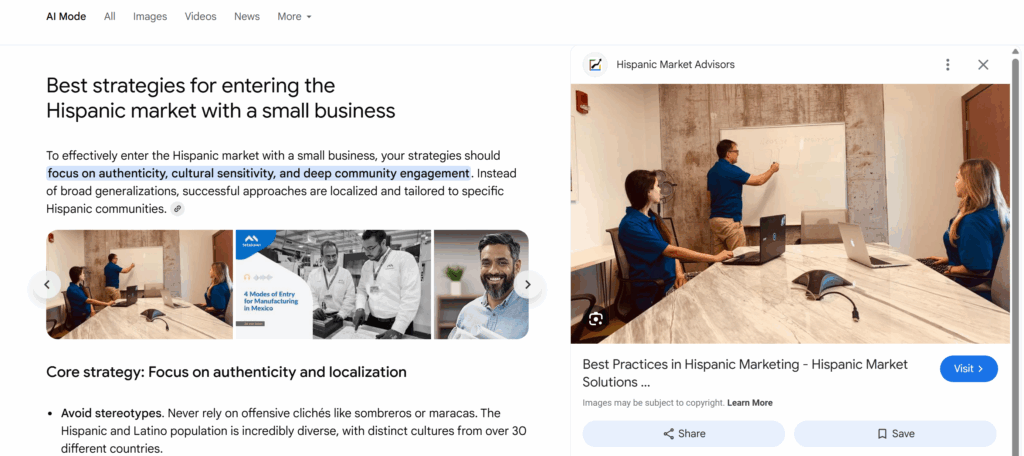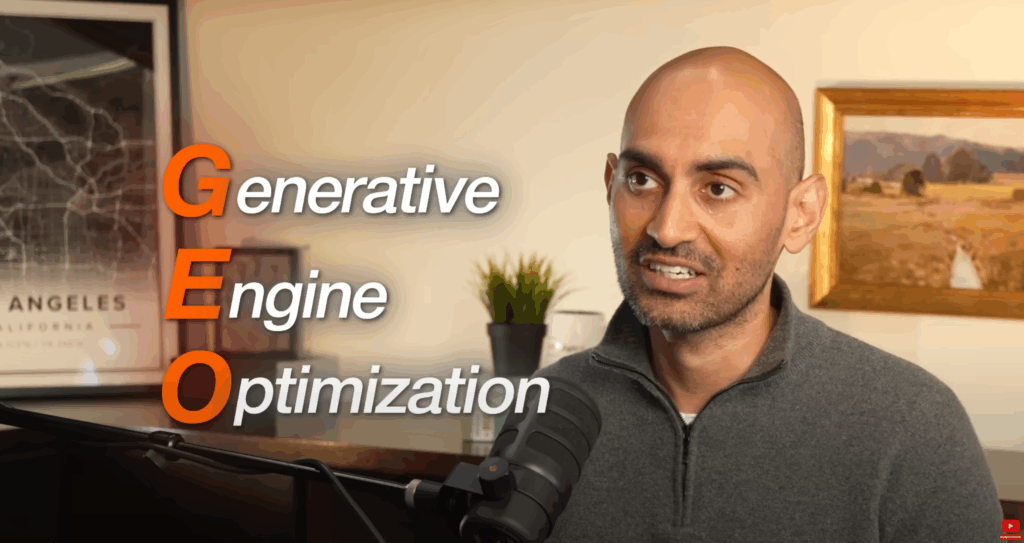Google’s AI Is Rewriting the Rules
For years, traditional SEO focused on keywords, backlinks, and optimizing for the blue links on Google’s results page. But with the rollout of AI Overviews and Google’s increasing reliance on generative AI, the rules are changing. Google is becoming less of a search engine and more of a curated answer engine—deciding not just what results show up, but also who gets cited.
On This Page
- Where AI Overviews Actually Show Up (and Where They Don’t)
- Why the Real Battle Is for Citations, Not Clicks
- How to Reverse-Engineer the Content AI Already Trusts
- The One Move That Turns Search Into a Brand-Building Engine
- Why This Matters for the Latino Market
- The Role of Spanish SEO in an AI-First World
- Final Takeaway – Generative Engine Optimization
Where AI Overviews Actually Show Up (and Where They Don’t)
AI Overviews don’t appear on every query. They’re most common in complex, multi-step, or exploratory searches where users want quick synthesis. For example:
- “Best strategies for entering the Hispanic market with a small business”
- “How AI is changing digital advertising”
They typically don’t appear for transactional or hyper-local searches like “coffee near me” or branded terms. That means if your business relies on visibility in thought leadership or educational content, AI Overviews are now your frontline.

Why the Real Battle Is for Citations, Not Clicks
In AI mode, Google surfaces a summarized answer, with citations at the bottom. Users may or may not click through, but just being cited builds authority. Think of it like being quoted in a major news story—even if readers don’t visit your website, your brand earns credibility and recognition.
This means that the new SEO playbook isn’t about chasing clicks alone. It’s about earning the right to be cited by Google’s AI.
How to Reverse-Engineer the Content AI Already Trusts
Google’s AI doesn’t pull from just any page. It prioritizes sources that are:
- Credible (authoritative, trusted domains)
- Clear (well-structured, easy-to-digest content)
- Comprehensive (covering the query thoroughly)
- Contextual (relevant examples, stats, or case studies)
The key strategy? Audit the AI Overviews in your niche. Search for your target queries, see who’s being cited, and study their content. Then, aim to publish something even more complete, structured, and trustworthy.
The One Move That Turns Search Into a Brand-Building Engine
Most businesses see search as lead generation. But with AI reshaping visibility, the smarter play is to view search as brand positioning. If Google repeatedly cites your company in AI Overviews, your brand becomes the default authority in your space.
That’s how search shifts from a traffic channel into a brand-building engine.
Why This Matters for the Latino Market
For U.S. Hispanic businesses and brands targeting Latino audiences, this AI shift is especially important. Latinos are one of the fastest-growing demographics online, with higher-than-average mobile adoption and strong engagement on digital platforms.
If Google’s AI decides who gets visibility in complex queries—like “best health insurance for Latino families” or “how to start a business as a Hispanic entrepreneur”—then Latino-focused businesses must position themselves as trusted authorities. Otherwise, they risk being overlooked in AI-curated answers.
Get in touch with us, and then decide.
Hispanic Market Advisors helps you connect with the online Latino market and expand your reach.
The Role of Spanish SEO in an AI-First World
Another crucial factor is Spanish SEO. Millions of U.S. Latinos search in Spanish—or in a bilingual mix of English and Spanish (Spanglish). Yet many businesses overlook this.
Optimizing for Spanish-language keywords, publishing bilingual content, and structuring information clearly in both languages increases your chances of being cited in AI Overviews. Google’s AI looks for diverse, inclusive sources—and content in Spanish can help your brand stand out in competitive niches.
In other words: Spanish SEO is no longer optional—it’s a growth engine. Brands that invest in Spanish-language authority will not only rank in traditional results, but also earn citations in AI-curated answers, giving them long-term visibility.
Final Takeaway – Generative Engine Optimization
Google’s AI isn’t just rewriting search—it’s rewriting authority online. For Latino businesses and brands targeting bilingual audiences, the opportunity is even greater: to use SEO + AI + Spanish content as a brand-building strategy. Businesses that adapt early will position themselves not just for clicks, but for lasting trust and visibility in an AI-powered search world.
Inspired by insights from this video on Google’s AI and Search (Neil Patel)



Leave a Reply